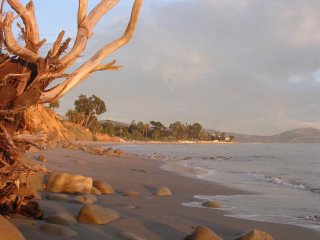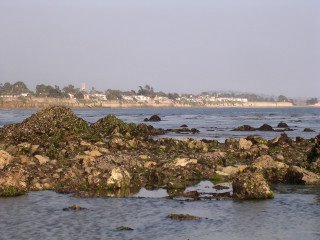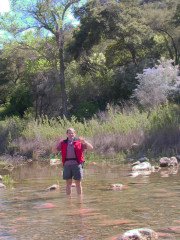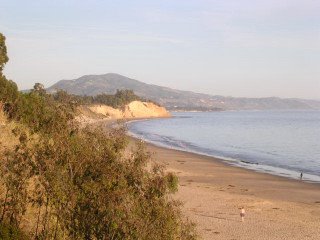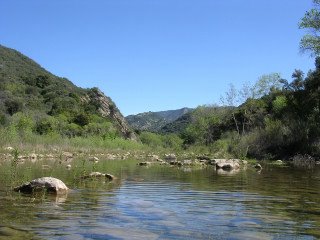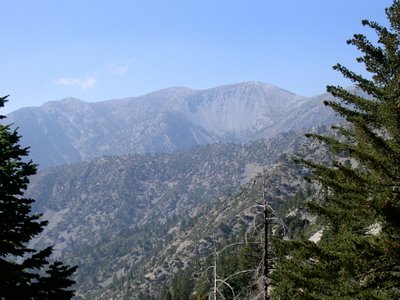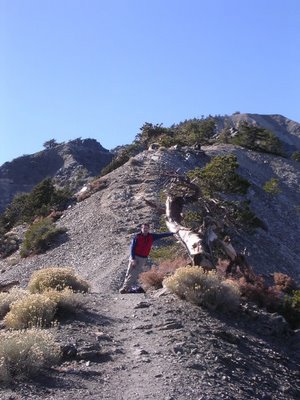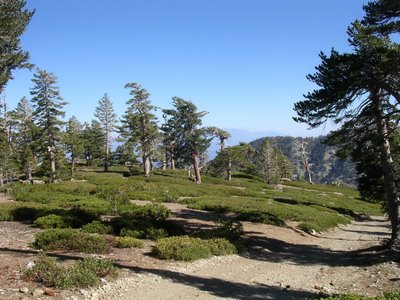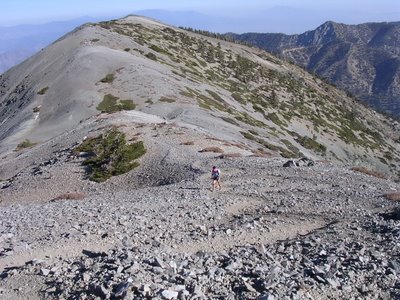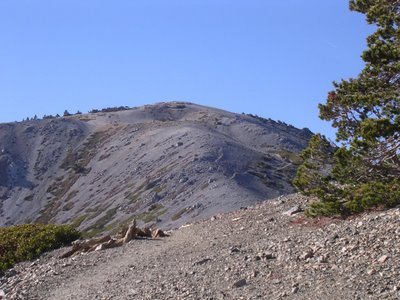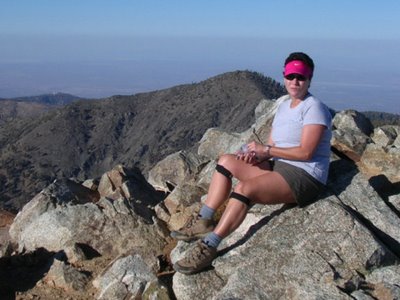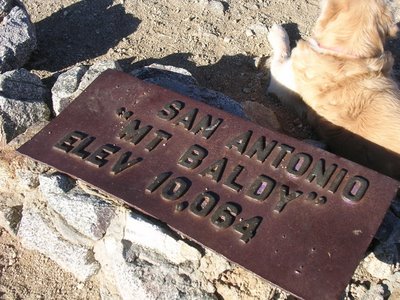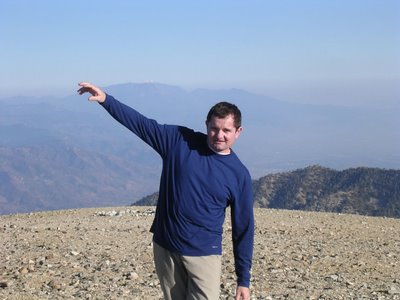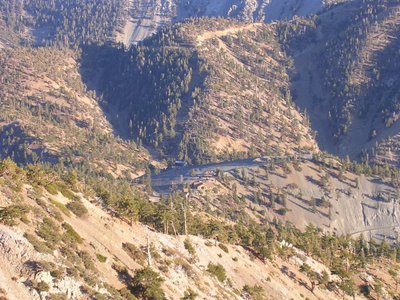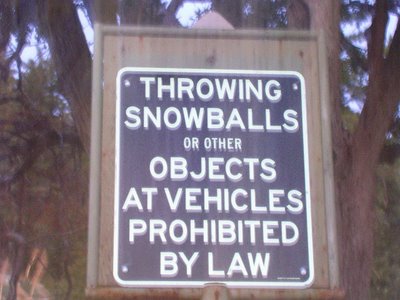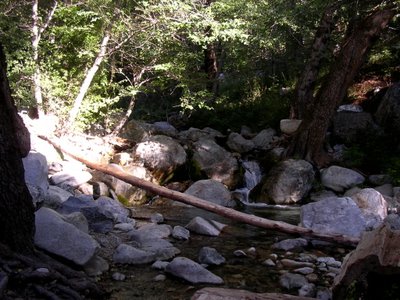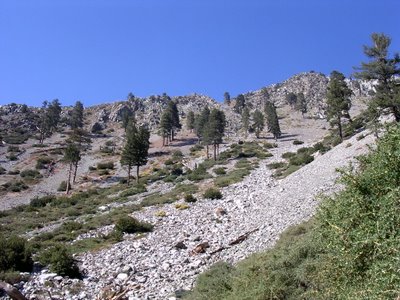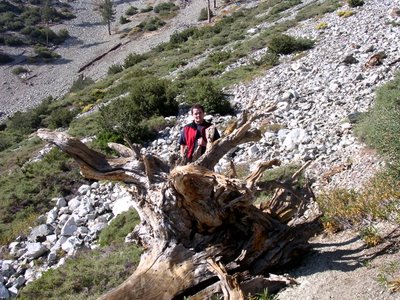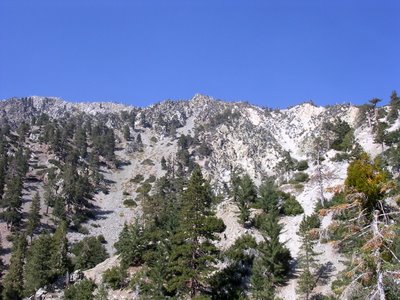A couple of weeks after I set up the Mount Whitney blog, I received an e-mail from my sister Anic who surprised me with the news that she would spend the fall in Montreal with her husband where he had been invited to teach a sociology class at the
Université de Montréal.
The last time I met Anic and Alain was in winter 2001 when I stayed at their house in a small Normandy village. I had wished to accompany her on a trip to Helsinki and St. Petersburg, but these lovely towns are still mighty chilly in early April and I opted for Istanbul instead.
I jumped at the chance to go see them and visit the world’s second largest French-speaking city, which captures a European sensibility enhanced by a North American sense of space. It is quite a thrill to experience a culture that has maintained a uniqueness on a rather homogenous continent.
The first leg of my two-week journey took me overnight to Boston. With enough time to check out the city, I hopped on the subway for breakfast in Cambridge. I have long had a fascination with the New England mythology: everything from the revolution to clam chowder to fall foliage to liberal politics.
Boston opened a new subway link that is in fact a rather ingenious way of combining the flexibility of a bus with the speed of underground transit.
Forty-five minutes after landing at Logan, I emerged in Harvard Square. My heart smiled at my very first sight of life in Massachusetts. A banner across a church founded in the 1600s proclaimed: “Support marriage equality – we do.” The commonwealth stands alone in its recognition of gay marriage, a singularity that is in no danger of being upstaged by other states where the mood is decidedly more toward limiting, or banning, rights.
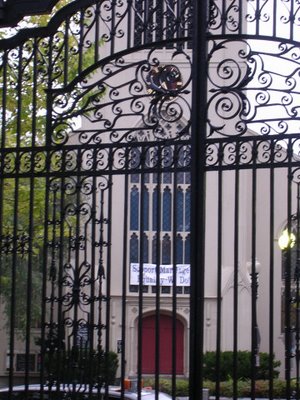
At the last election, Texas voters approved Proposition 2, with 76 percent in favor of the amendment that will inscribe a ban on gay marriage in the state’s constitution. Texas becomes the country’s nineteenth state to formalize such legislation.
Only Travis County, home to liberal Austin, thank you very much, bucked the landslide, with less than 40 percent supporting it, with a 25.15 percent turnout compared to the state’s 18 percent.
In some rural counties, the eagerness to slam the door shut was shared at times by more than 94 percent of the electorate. Then again, the turnout also dropped as low as 2.75 percent of registered voters.
Figures like these lead me to believe the good people of Texas left it to the rabid others to do their dirty work. When forces of oppression reach such levels, I am not certain we are still describing democracy in action. If we asked these same people whether inter-racial marriages should be banned, whether the right to vote should be taken from women, whether slavery should be reinstated, are you positive they would say no? And if they did vote for restrictions or bans, would you respect their wishes?
State figures show that less than 14 percent of registered voters (76 percent of the 18 percent turnout) were in a position to change the constitution. Whatever the reason the other 86 percent decided not to vote, it remains that the stability and equanimity of a pluralistic democracy should not hinge on the hatred of a small minority with free time on Tuesdays.
Strolling around the Square, even at 7 a.m., I sniffed the awakening of a certain intellectual energy. Across the St. Charles River from Boston, the independent city of Cambridge functions like Berkeley to San Francisco. Except on a broader and more historical scale. The narrow streets, compact dwellings and leafy trees give a sense of an established community where a lot has happened, and a lot more is due to happen. Harvard University was established in 1636. Nearby, the Massachusetts Institute of Technology is a late arrival in 1861.
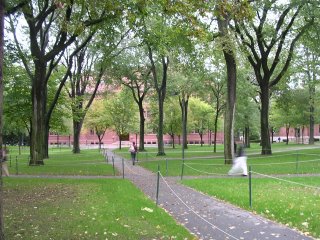
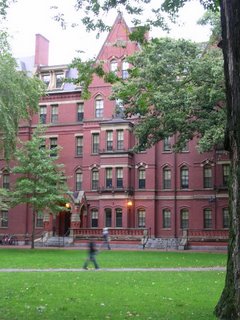
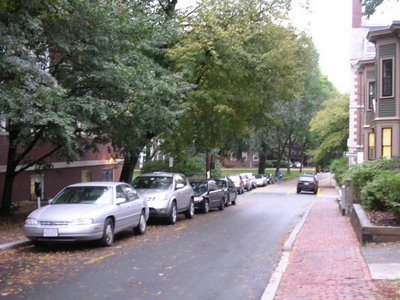
Back on the T, I emerged at the Boston Commons, set aside in 1634 for public grazing until the neighbors complained of the smell. I crossed the park to the State House and followed meandering streets through the downtown core, where high rises adjoin buildings dating to the foundation of this nation. For someone with but a cursory knowledge of this period, my casual walk brought the likes of Paul Revere, Samuel Adams, John Hancock, Benjamin Franklin and Josiah Quincy alive.
I dropped by City Hall, Faneuil Hall, the Quincy Market and the Old South Meeting Hall from which balcony Samuel Adams gave the signal that started the Boston Tea Party. (There is more than beer to the dude!)
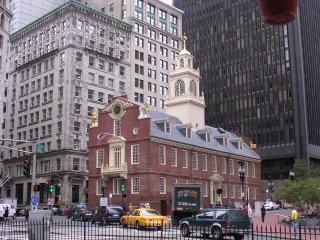
Even though I had slept little, the plentiful history energized me. Delta had booked me on Song, its low cost subsidiary, between Los Angeles and Boston. I perused the menu and was quite surprised by the intriguing choices. I would have gone for the curry, had I not eaten just prior to the flight, but I did get a Sunrise Martini. The flight attendant asked if I was celebrating anything special.
I got busy with the in-flight entertainment, checking out the satellite television channels, creating my own music selection from among 1,600 MP3s, and playing trivia games. At first my response time had me ranked dead last, a shame that the martini did not dull. By the end of the round, I had leaped to number one and when “Benoit is the winner” and my seat number flashed on the screen, I readied for my moment in the spotlight.
Alas, no flowers came my way, the pilot did not broadcast a congratulatory speech. My solitary victory came over western New York State. The bulk of my sleep came between Taos, N.M. and the Mississippi River (which I identified on the flight tracker), not nearly enough for a day that was now going to take me to yet another time zone. (More trendy than the mother ship, Song would be discontinued nevertheless the following spring.)
My general sense of Nova Scotia was of an island buffeted by bone-chilling winds. The province looks like an island, but, attached to the mainland at the New Brunswick line, it is not. Someone I met once told me the Cape Breton highlands resemble California’s Big Sur, and the pictures I have seen attest to it. In spite of tempting Celtic festivals and the chance to attend a ceilidh, I had time for only a visit to Halifax and a trip down the coast to Lunenburg.
The weather in Halifax was spectacularly gorgeous on arrival day. It was but a tease, as temperatures would dip in a hurry and coast around 7°C/45°F for the bulk of my Canadian visit.
When I met my friend Peter, he surprised me by stating that fall and winter in Nova Scotia are in fact milder than Québec or Ontario. I have checked the weather pages and confirm that Halifax rises several degrees warmer than Toronto and Montreal. Thank the ocean’s mitigating act.
I met Peter when I lived in New Mexico, and so did he, clearly! It was interesting to see him after a good 10 years. We met on Argyle Street in front of the Economy Shoe Shop, not a retail business but a club. To reminisce, we gathered around an eclectic table at Jane on the Common.
I chose to introduce myself to the city by visiting the Citadel. The British built four successive forts on the hill above Halifax starting in 1749. The current fortifications date to 1856 and were intended to deter an invasion by the United States. I followed a very instructive tour capped by the firing of the Noon Gun and bagpipe music by students who re-enact the 78th Highlander Regiment.
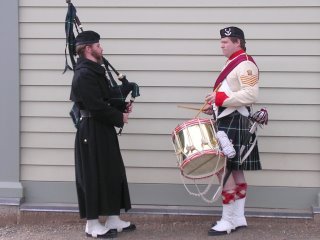
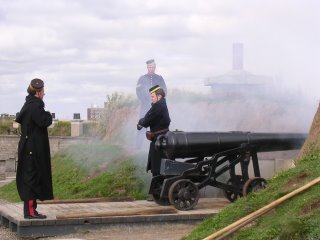
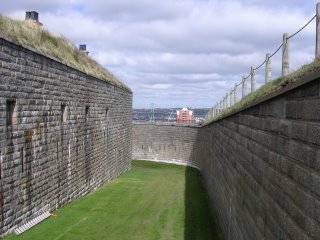
Like most Canadian cities, Halifax is easily explored on foot. The Historic Properties, harbour, downtown, Grand Parade, Public Garden are within close proximity. Notwithstanding its location at the edge of the North American continent, the hilly city – not quite the San Francisco of the Atlantic, though – is far from an abandoned outpost and benefits from a mix of students and professionals. The same location had Halifax answer the call to rescue when an ocean liner on its way from the U.K. to New York sank. In a pond at the Public Garden floats a miniature replica of the Titanic, wholly above water.
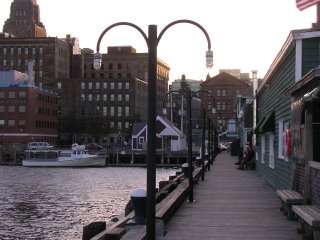
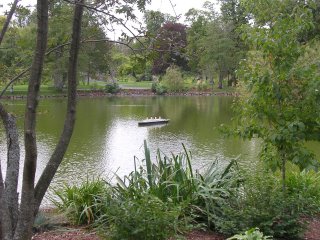

Many of the city center’s brick buildings have been restored to shelter both commercial ventures and residences. Human-sized, colorful and organic lobster art graces downtown streets, much like moose did in Park City during the Olympics. What I find particularly noteworthy in Canadian cities, and that holds true in large towns I have visited like Victoria, Vancouver, Toronto, Ottawa, Montreal and Québec (moving eastward, for the geographically alert) is their compactness and mixed-use downtown core. Urban environments privilege the pedestrian and public uses, and present a human face. At Metro Transit bus stops in Halifax, riders can dial an automated system that provides the precise arrival time of the next bus. I have yet to find outlandish displays of wealth common in most American cities; nor have I found the crumbling ghettos that also plague our urban landscapes.
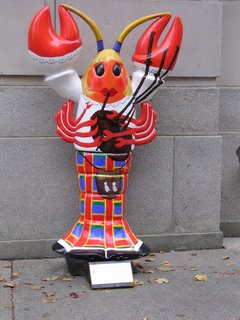
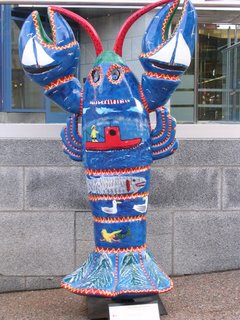
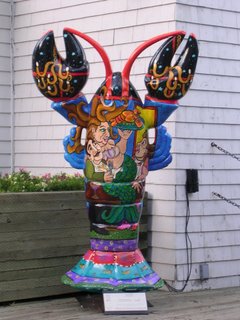
As Halifax seemed to have higher than normal hotel rates (by Canadian standards) I elected to stay at the Backpackers Hostel, obviously attracted by the name. The staff is quite friendly and the CDN 20 rate very reasonable, but I found it difficult to get a good night’s sleep in a slightly ramshackle facility and with one of my four dorm-mates having recurring nightly needs to use the bathroom. I was surprised to be among the younger ones at this hostel, where I suspected my advanced age would have branded me apart. Very round St. George's Anglican Church stood guard around the corner.

The Studio at the Neptune Theatre staged “Death of Yazdgerd,” an Iranian play written during the tumultuous days of the 1979 revolution. Ironically, it explores the resistance to Arabic expansion of Islam in Persia. The more things change, the more they stay the same. I would have enjoyed this serious play more if I had not been fighting the consequence of trans-continental travel, little sleep and visits to two cities.
Peter took the Friday off and we journeyed first to insanely famous Peggy’s Cove, a half-heartbeat of a burg fully devoted to the worship of tourism. The surrounding area is pretty, but the village, if that is truly what it is, is as disappointing as it is popular. Nearby is a monument to the victims of Swissair flight 111’s crash into the ocean. When the news first arrived, reporters misidentified it as a traveling from New York to Zurich, something I picked up on only because I had twice been a passenger on flight 111 on my way to Geneva. All European-bound flights from the east coast follow an arc that hugs the coastline before veering right at Newfoundland. Nova Scotia is about two hours out of New York and it is after sighting it that I would settle for the night.
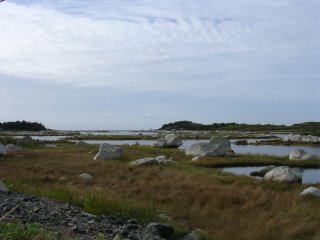

Mahone Bay is a lovely village where Peter and I goofed around with the RCMP straw replica set out in front of Canada Post for Halloween. The town had adopted a mischievous spirit, evidenced by the many such decorations.
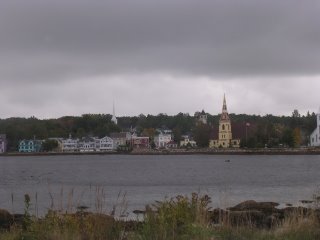
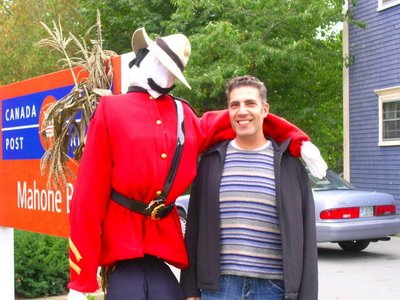
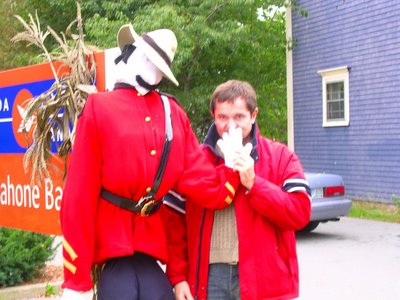
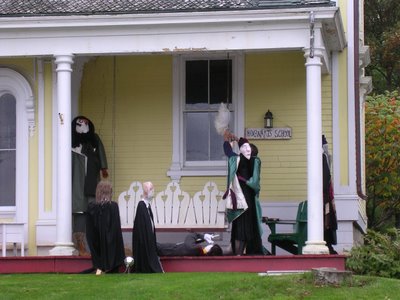
Lunenburg is a UNESCO World Heritage site and showcases dozens of beautifully preserved buildings. We spent quite a bit of time chatting with an elderly woman at St. John’s Anglican Church. Her husband helped with the restoration of the wooden structure, first erected in 1753, but severely damaged in a November 2001 fire. It is a magnificent building. The Academy, or high school, has been welcoming students in its present location atop a hill since the waning days of the 19th century and is equally striking.
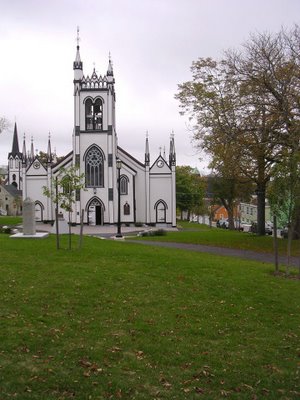
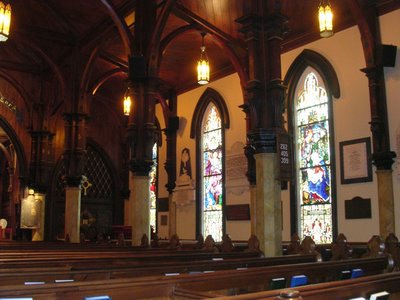
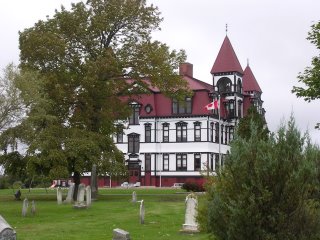
We took a short walk on low cliffs above the shore of the Atlantic to the Oven Sea Caves where strong currents send waves crashing loudly against battered cliffs and did not have time for the Fisheries of the Atlantic Museum, a museum I wanted to check out.

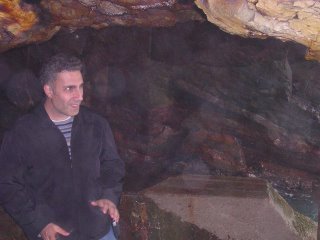
Back in Halifax, Peter took me to a Lebanese restaurant, a cuisine that I seldom sample for lack of opportunities. For my last night, I moseyed on over to the Old Triangle Alehouse and, local draft in hand, I sang along to songs I didn’t know and reacquainted myself with the Irish in me I never knew.
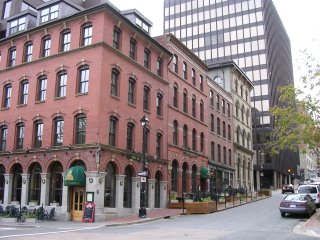
Before the crack of dawn, I rushed out of my not-so-cozy digs, jammed over the Macdonald Bridge to Darmouth and on to the airport located a hell of a long ways away. I think they picked the site to be out and away from civilization, as there is not a single building for kilometers around!
I left the Maritimes as the sun rose and landed in Montreal after an hour and a half but only 30 minutes later thanks to the time difference (Nova Scotia is one hour ahead of Eastern Time). I had hoped to see Maine but a blanket of clouds obscured the landscape below. Had I had more time, I would have journeyed there by train though New Brunswick and Québec’s Gaspésie, and along the south shore of the St. Laurent (St. Lawrence), a trip 20 hours long.
Off I was into the Laurentides and the resort town of St. Jovite and the slopes of Mont Tremblant, one of the largest ski resorts on the East Coast. I got majorly stoked at the site of red and sugar maples, all bearing their fall finest. I started to dream when I spotted the "Skiez et Revez." I stopped by a small café and felt I belonged.
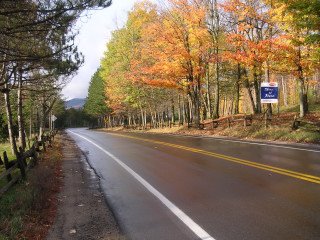
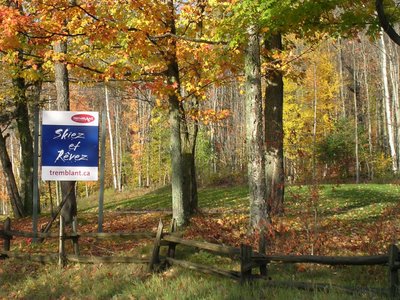
It was but my second visit to Mont Tremblant, but I drove to the resort as if it was my hundredth. The most acute pleasure I extract from bouncing around the planet is a sense of communal belonging, heightened when I intuitively find my bearings. In Paris and San Francisco, of course, but also in London, Singapore, Amsterdam, Rome and other cities, I swim with or against the current, but without a map.
I could not bear to stand in line to purchase a gondola ticket so great was my excitement. A quick stop at the counter confirmed I could obtain a one-way ticket at the top. Immediately the trail yields orgasmic colors and a riot of fall smells. The drizzle ceased and I merrily stepped upward by a waterfall, through evergreen groves, around a beaver pond. I circled the beaver pond twice, in fact, not noticing I had accidentally retraced my steps! Higher, the Grand Brulé trail crossed ski runs now choked with brush. Low clouds and fog crept in making visibility somewhat questionable. At the summit, I could see no more than 10m/30ft ahead, but I was exhilarated. At 875m/2,871ft, it ain’t Mount Whitney – or in fact much of any mountain out West. The 610m/2,000ft climb isn’t much either, but it was still awesome. I went inside the cafeteria and asked about a particular cake. Unfortunately, I could not make out their French and never quite understood the response, which was kindly repeated three times.

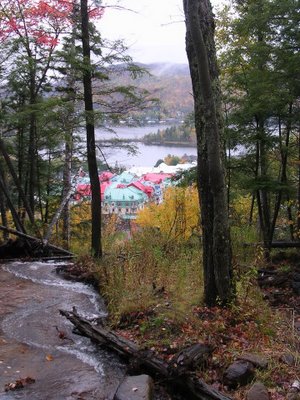
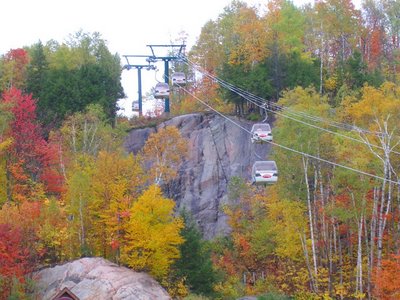
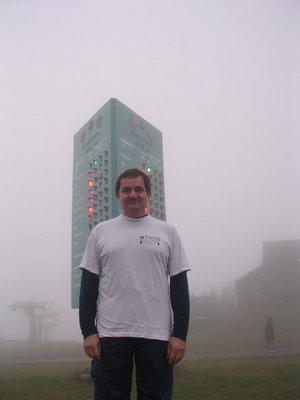
I rode the gondola down (CDN 5 – compare that to U.S. ski resorts, will you?) which slowly ducked under the cloud cover to reveal the village where I spent a couple hours snacking on French pastries (notice a theme yet?) and shopping at Roots as is my habitual addiction when north of the border. How could I turn down sweat pants in a size small when medium or large customarily fits me?
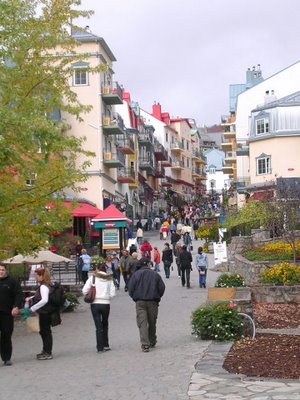
To reach Ottawa, I navigated the back roads of the gentle Québec countryside down to the Rivière des Outaouais/Ottawa River before paralleling it upstream to the capital, marveling at the sun setting over Ontario, on the south side of the river, one bridge and one language away.
In contrast to my Halifax digs, my room at the Rideau Inn was spacious and elegantly Edwardian. Too bad I wasn’t there in winter because I would love to see the frozen Rideau Canal, which people use to skate from one part of town to another. In fact, they could skate all the way from Kingston on Lake Ontario 202 km/125 mi to Parliament Hill overlooking the Ottawa River.
My wish to spend time in Ottawa was predicated by the Canadian government’s decision to allow gay marriage in a June 2005 parliamentary vote. By then, seven of the country’s 10 provinces already had legalized it, but the measure, introduced by the Liberal government of Prime Minister Paul Martin, displayed vision nonetheless. Not that the opposition mounted a fierce campaign, but because legislators in the U.S. and their constituents have seized upon the idea of gay marriage to channel their hatred and fears into political opportunism. As state after state passed constitutional amendments to forever ban the idea, with some vocal groups screaming for a federal amendment, you can say the strategy has worked. Don’t rush too hastily to blame our current state of affairs: The first politician to seek a ban on gay marriage was President Clinton with his hysterical Defense of Marriage Act.
In this context of exalted discrimination, Canada’s bold act plows our horrendous mediocrity under. I had to pay my respects. I signed up for a tour of both chambers of Parliament and learned a lot about the country and its political institutions. I noted that four parties occupy the House of Commons: the Liberals, Conservatives, New Democrats and Bloc Québecois. The Liberals lost the January 2006 elections and the Member of Parliament breakdown now stands at 125 Conservatives, 102 Liberals, 51 New Democrats and 29 Bloc Québecois. That allowed them to elect Stephen Harper as new Prime Minister and leader of a minority government. Since the other three parties often join ranks, they will moderate his policies.

The Liberals’ decline began when their coalition partners reacted to a corruption scandal by handing them a vote of no confidence that precipitated the election. While I would (obviously) support the Liberals, I also regard them as having some major fuck-ups that will not get resolved by remaining in power. The New Democrats and Bloc Québecois could have sided with the Liberals and ensured they remained in power, but they opted to vote with their conscience.
A political party must not feel it has some sort of entitlement to rule. In the U.S., Democrats blamed Ralph Nader for the loss of the 2000 presidential elections, arguing that Mr. Nader siphoned votes away from Al Gore.
But why would a candidate withdraw for the benefit of a party that has consistently proved inadequate? Mr. Nader, just like the New Democrats and Bloc Québecois, has an obligation to himself, not to another party. The Democrats could have worked harder to motivate their base and show in greater numbers at the polls.
More critically, why do people continue to vote for a party they recognize as being inadequate? I once asked Elisabeth to state her top five concerns. She mentioned health care, the death penalty, the criminal justice system, abortion rights and energy policy. In the best of circumstances, Democrats are lukewarm advocates, quick to blame the political climate for their shortcomings. In my 25 years in this country, no gains have been made in those areas and I would argue the situation is legally far worse. Should Democrat voters like herself pretend another 25 years will bring an advocacy that has rarely, if ever, surfaced?
Republicans have botched so much and brought so much derision on the world scale that one would imagine Democrats would have a field day opposing them. They haven’t capitalized on the ongoing fiasco because they are just less so of a failure.
I cannot conceive of endorsing the Republican agenda. For a true alternative, let us not bemoan the absence of choice. Canada and all other democracies handle political plurality. We can have a viable third party, too. First step forward is to crush the delusion Democrats are the solution.
I also noted that it was Prime Minister Lester Pearson’s government that brought in national health care to Canada. Back in the 1960s – imagine that!
A civilized nation views life as more than a contest between winners and losers. A civilized nation does not imprison and execute record numbers. A civilized nation does not foster destruction in other countries.
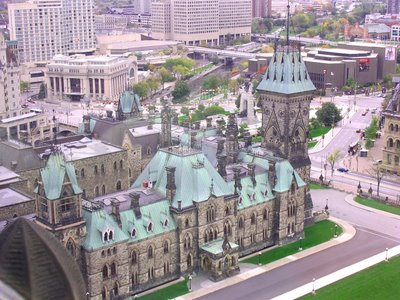
To the back of the House of Commons is a shelter for cats maintained by volunteers. Black squirrels also visit the shelter and relax. I dropped a toonie.
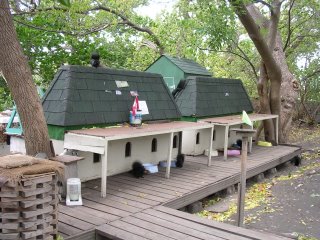
Since I had not visited it on my previous trip, I walked over to the National Gallery, which goes by the slightly different name Musée des Beaux-Arts du Canada in French. I enjoyed the contemporary installations both inside and outside of the architecturally striking building. I eavesdropped on a conversation and picked up how to say moose in French. No one in France recognizes the word orignal, though.

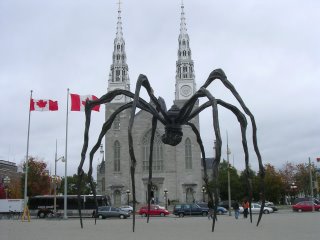
Before heading back toward Montreal, I went on a little exploration inside funnel-shaped Parc de la Gatineau, which stretches over 45km/28mi of forested hills and lakes. Mountain biking, skiing (both downhill and cross country), swimming, boating, fishing, and hiking lure visitors to this little urban wonderland in the middle of the city of Gatineau, on the Québec side.

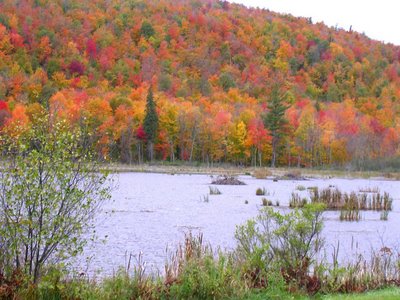
When I first visited Ottawa, the city directly on the other side of the river was called Hull. As it has happened in many other Canadian cities, municipalities have “amalgamated” together to avoid duplication of services. The model is a worldwide norm, with urban areas served by common agencies with an eye toward simplification.
It is an anomaly in the U.S. The nine-county San Francisco Bay Area has, for example, fourteen different, sometimes competing, public transit agencies: buses, subways, short and long-distance trains, and ferries operate independently, rarely with integrated service and fare structure. The short journey from the University of California Berkeley campus to San Francisco’s Golden Gate Park likely will involve a bus trip to the subway station and another bus transfer to the park, for three different fares paid separately.
Not complicated enough?
Try this: Each of these companies operate its own police force, which might seek assistance from a number of other law enforcement agencies, depending on where one is during the trip. It could be the Berkeley city police, Oakland city police or San Francisco city police. If you happened to transit through an unincorporated city, the sheriff would get involved. And if you drive on a state highway or the Bay Bridge, the California Highway Patrol takes over. State and federal governments have their own forces, too. (Keep in mind that the same violation may carry vastly different penalties, depending on which jurisdiction has control.)
The goal, then, is to create municipalities that can oversee a coherent system of public safety and transit. Gatineau is one such result, having engulfed a number of existing towns into its fold. Versions of this approach exist in Vancouver, Toronto and Montreal.
I followed the advice of the friendly – aren’t they always? – rangers and headed for a loop trail from where I could glance at the surrounding capital region. It was a brisk day, but the fall colors perked me up!
I shunned the freeway toward Montreal for country roads, this time on the Ontario side. For two hours I listened to a literary program on Radio-Canada, the French counterpart to CBC Radio. The intellectual discussion stimulated me. No such national network of several radio stations exists in the U.S. where the notion of a commercial-free discussion on books does not inspire too many people.
It was dark when I cruised into town and knocked on my sister’s rue Drolet apartment on the Plateau, a very lively neighborhood around St. Denis and Mont Royal streets. As we unloaded my gear, I left my hiking boots behind, something I only noticed a full day later, by which time said shoes were a-goner.
Anic is my oldest sister, the mother of my two nephews Eric, a pilot with Air France, and Sylvain, a marketing consultant in Lisbon. It has been a good ten years since I last saw Eric, but I met Sylvain when I was in Paris last, and his mom, whom I visited at her Normandy home. Of course there was a lot to catch up on, and most peculiarly in my case as my sister is estranged from my mom and the both no longer talk. The stories I hear have two, often divergent, angles.
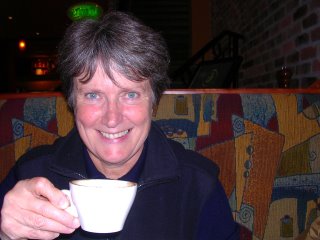
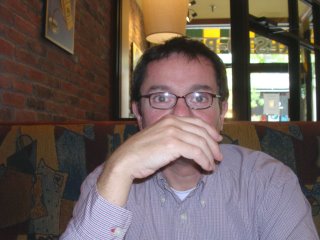
With her husband Alain, we discussed life. Because of my geographical isolation, I soak up each bit of news and information as representing parts of my core identity. I feel cared for, not in an overreaching way, and it pleases me a lot.
Even when I walked the streets of the cold city – the temperature never crept above 7°C – I carried with me a sense of belonging and of origin. I have been to Montreal five times, and can find my way with ease. Surprisingly, it is a mostly bilingual city, a peculiarity I had not expected. News reports portray Québec’s linguistic preoccupations as a cleavage along English- and French-speaking lines. Whether in anglophone Westmount or francophone Outremont, Montreal residents can often converse in both languages. Away from the cosmopolitan city, it is history that dictates what language is spoken. Many regions of the province have never spoken much French, like the Cantons de L’Est, or Estrie, east of Montreal. The Québecois de souche (or, comically, called Québecois pure laine) is likely to speak an old-French dialect called joâle, wholly unintelligible to my ears, but which makes sense to the local population. English terms migrate into French, sometimes untranslated (C’est le fun!), sometimes hilariously adapted (Je ne veux pas de trouble avec mes acquintances).
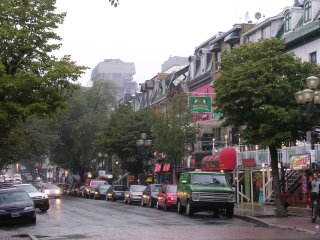
As a minority language in an English-dominated country, French speakers worry that a low birth rate (which was astronomically high only a generation ago) coupled with new immigrants’ understandable preference for English, the language of commerce, spell trouble. The province occupies a huge chunk of the Canadian and even North American landscape. At 1.541.971 km²/595,391 sq. mi., it encompasses the combined area of California, Oregon, Washington, Idaho, Utah and Nevada. Most of its 7,230,000 people reside within sight of the Rivière des Outaouais, the Saint Laurent or the border with the United States, occupying only one eight of its territory.
This free flowing mixture of languages and cultures invigorates me. I love the common “Bonjour Hello” greeting. It sets the tone perfectly.
Can a Canadian identity be established without attending a hockey game?
Resoundingly no!
It fits me fine. On occasion, I enjoy watching games, but ticket prices for the Los Angeles Kings at the Staples Center blow me out of the ice rink. The cheapest, regular season, nose-bleed seat goes for USD 26.50. Rink-side tix fetch – I’m not making this up – USD 424.50, for crying out loud!
For years, I have owned a Canadiens puck. It was time to preside over a game against Boston’s Bruins at the Centre Bell. I paid CND 34.86 (charged as USD 30.82 on my card) for a decent seat from where I became a “partisan,” the chosen French translation for the word fan. In France, “partisan” applies most commonly to a fighter during a conflict, or a member of a political party. It sounds quite odd and funny to use it in the context of a sporting event. The Canadiens scored 2-1.

For the record, the cheapest tickets in Montreal cost a mere CND 10, and the most expensive go for CDN 182.50. Must I point out the obvious?
HMV DJs always play cool music and help me discover new sounds. I picked up several CDs by hard to understand but infectious Sean Paul, Peruvian artists by way of France Manu Chao (which I played continually on Song), protest singers Les Cowboys Fringants, atmospheric Sigur Rós and Roka Trauré from Mali.
To stack up on books I cannot get at home, I perused the racks at Archambault, Renaud-Bray and Chapters/Indigo. A self-respecting French person, I could not resist and got myself “Le Ciel lui Tombe sur la Tête,” the latest in the Asterix adventures. This comic strip crosses over all generations.
My shopping instincts are pretty free flowing, but purchases have to conform to a peculiar rule.
The Canadian government levies a seven percent Goods and Services Tax, which Revenue Canada kindly offers to refund to visitors. Each receipt must show CND 50 – hence my spending guideline - and amount to a minimum CDN 200 in total. I estimate to have collected more than USD 100 in refunds over the years.
Walking around Montreal is eminently pleasant. Save for the hilly Mont Royal, the city is flat and compact. When it gets too chilly or when the distance is too great, I hop on STP buses or subways. My sister recommended a weekly pass for CND 18.50. I made good use of it.
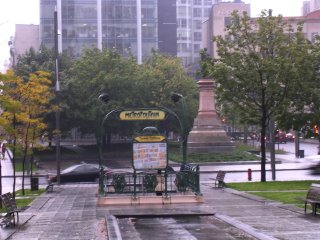
In the city center, subway stops link to the underground city, an extensive network of tunnels under streets and buildings. Hundreds of retail businesses line those tunnels, sometimes simply the basement version of a street-level shop, at other times wholly subterranean. I am not a fan of indoor shopping, but some parts of the underground city are very lively and agreeable, sometimes more so than on the streets above. I have learned to duck underground when rain storms hit, walking below office buildings, train stations, subway stops and monuments. In winter, frozen residents never have to leave heated confines to commute, work, shop, dine and entertain. Year round, I suffocate in the overheated subway cars.
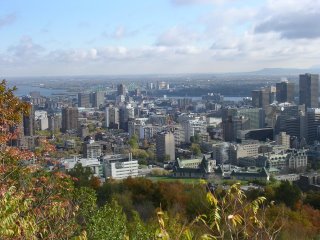
The Societé d’Alcools du Québec stores are a great place to plan festive gatherings. Beer and wine may be sold anywhere in the province’s dépanneurs and markets, but SAQ stores carry a greater selection and also hard liquor. Unibroue’s potent fermented ales draw my eye time and again. Cute names (La Fin du Monde: the end of the world; Eau Bénite: holy water; La Maudite: the cursed) belie the flavorful nine percent alcohol content. They’d go well with poutines, but will stand with a fine meal, too. More unusual is the ice cider Neige, which I imagine at home with a Tire à l’Erable sur Glace, when warmed maple syrup fresh from the tree is rolled onto packed snow or ice.
Far from drab, nondescript entities designed to instill guilt in purchasing booze, SAQ retail stores, like those of the Liquor Control Board of Ontario, encourage consumption. They stock elegant and inspired displays, offer serving and pairing suggestions in a smart, bright and trendy atmosphere with, pardon me, a buzz. I love it when the government demystifies drinking. On that note, the legal age is 18 in all provinces, except Ontario where it is 19.
In Isla Vista, a small but high-density community near UCSB on the outskirts of Santa Barbara, yearly fears of disturbances prompt officials (who chomp at the chance to side with law and order) to devise strategies of all sorts to crack on Halloween parties. To prevent large gatherings, parking is restricted to residents only and the town is essentially barricaded against a possible influx of visitors from the outside. The next day, the news media are filled with stories of underage drinking, driving, and alcohol-fueled stupidity.
Anic and Alain invited to dinner a university colleague who specializes in the role of alcohol in society. She could not imagine a similar scenario in Canada.
Perhaps, just perhaps, if you treat people like idiots, they just might behave like idiots.
(For those unfamiliar with the myriad of rules in California, note that consumption or purchase of alcohol (as well as non-alcoholic drinks) by minors – read under 21 – is strictly prohibited. Even a parent is not allowed to order a glass of wine for an underage child. In California, at least, a 20-year-old clerk may sell packaged beer. In other states they have to call on an older clerk. Violations range from fines to imprisonment.)
I spent many hours walking around, from the top of the Mont Royal, all the way to the Vieux Port. I dropped by McGill University where my friend Eytan studied several years ago. From Long Island, he had said even out-of-country tuition at this private university was less expensive than at state universities in New York.
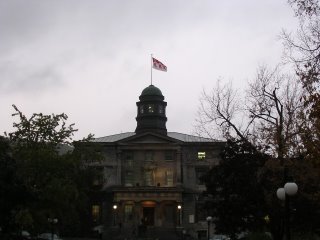
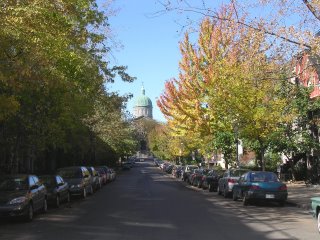
The displays and exhibits at the nearby Musée McCord d’Histoire Canadienne detailed Montreal’s history more comprehensively than at the Pointe-à-Callière in the Vieux Port. The old photographs and artifacts from the Growing up in Montreal installation evoked a bygone era convincingly. The triangular Pointe-à-Callière shouts modernism in the oldest part of the city, but it does not displease. Its shape and name denote a waterway confluence. Docks have pushed back the Saint Laurent, and its feeder creek has been filled in. You had to be there 300 years ago. The relics and underground excavation carry visitors back to the days of the Old Customs House. An audio-visual presentation incorporates holograms and is arresting. At any rate, I was glad to be inside from under a cold drizzle and miserably gray skies even as I hungered for a bit more.
The Vieux Port borders the St. Laurent, a massive river navigable all the way from the Atlantic Ocean. Montreal itself is an island in its middle. Historic buildings and homes line narrow cobblestone streets, site of street performances during the warmer months where Guy Laliberté juggled his way to greater success with his intensely powerful Cirque du Soleil creations. Each new show premieres here, headquarters to the worldwide phenomenon, but no museum or tribute stand to tease Cirque devotees.
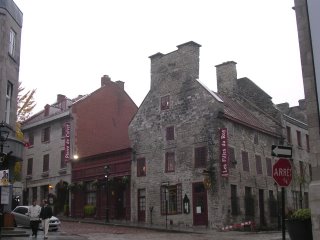
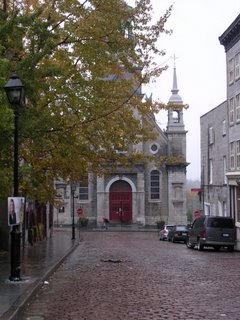
Obligatory horse-drawn buggies ply these delightful streets. They participate in the romantic vision of this most European of North American cities. Duck here and there for architectural and historical surprises. On my first visit, I learned that the Château Ramezay, a rough-stone residence commissioned in 1705, hosted American generals Benedict Arnold and Richard Montgomery during a (brief) invasion, a year before they got busy against the British.
Across the street, l’Hotel de Ville imitates the city hall in Paris. The neoclassical Marché Bonsecours served as city hall for a few years in the mid-1800s. The wet soles of my shoes squeaked on the floor as I walked past a few retail stores. More alive than just a few years ago, this simulated market still lacks something vital.
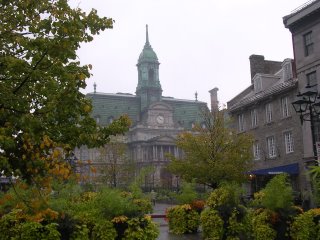
In the early stages of my culinary education, I watched and noted my sister’s preparation and cooking. While Canada uses metric measurements, the stove oven in her apartment displayed the temperature in degrees Fahrenheit. This confounded Anic who wondered what recipe would call for 425°, initially thinking those were degrees Celsius. To avoid charring everything, a blackboard in the kitchen had a few equivalencies translated.
To prepare our little dishes, we shopped at neighborhoods butchers, delis, cheese shops and bakeries. We selected fruits and vegetables at the venerable Marché Jean Talon, a permanent farmers market with stalls covering a square block. The prices in the pictures are for a full bucket, not per kilo. Some of the produce hailed from California and sold for less than it does there! Beyond the expected produce, the pleasures of the table embrace all manners of fish and fowl, food stuffs viewed as customary ingredients to good eating, not elitist predilections.
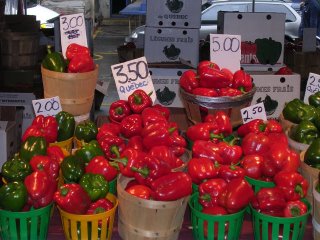
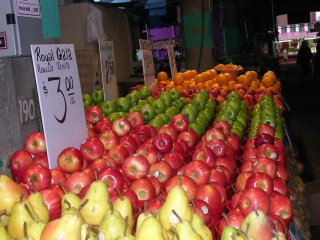
Anic selected a rabbit and a cider and I scrutinized her preparation. I would later repeat this recipe and others at home, to my and Elisabeth’s delight. Minus the rabbit - don't jump to conclusions.
Smaller public markets pepper the town. It is immensely pleasurable to come upon independent retailers at random and purchase fresh artisanal products priced fairly. At a stall on Cote-des-Neiges near the Université de Montreal, I picked up a basket of gooseberries, a tasty bite-size fruit wrapped in a papery sheath. Restaurants from Halifax to Vancouver serve it as garnish on many dishes. I first tasted it in Costa Rica, but I have never seen it in the U.S. 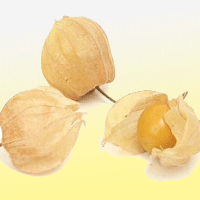 Foods produced outside industrialized agriculture come with a hefty price tag below the 49th parallel, fetching at a very minimum twice what they would in Europe. Smelling freshly baked pastries often proved irresistible.
Foods produced outside industrialized agriculture come with a hefty price tag below the 49th parallel, fetching at a very minimum twice what they would in Europe. Smelling freshly baked pastries often proved irresistible.
I reasoned that I walked many kilometers as I strolled around the city. The French word that I want to use is “flâner,” but I struggle to find a translation that captures the spirit. If I say wandering aimlessly, it connotes idleness as if having a goal was paramount. Flâner is to let the simplicity of the moment casually move you along to another discovery without insisting on a final proposition.
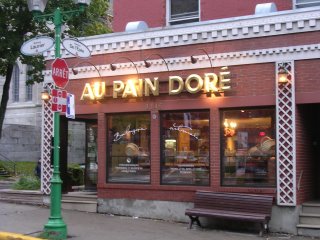
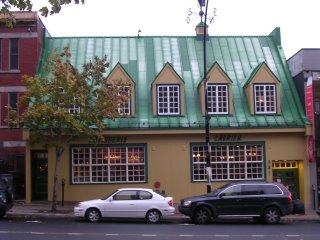
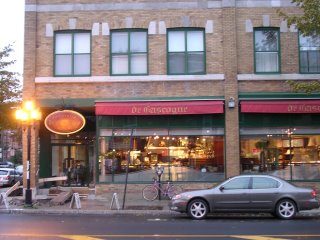
Je flâne, tu flânes, il/elle flâne, nous flânons, vous flânez, ils flânent tous!
On Rue Saint Laurent is a very small restaurant where I rest after too much “flâning.” The owner, in the picture, let me photograph the menu after I promised I would not divulge his trade secrets. Enlarge it and check out the prices: A lunch of a hamburger, fries, beer and espresso at Patati Patata will set you back CND 6.25. I would like to know in which large American city I may have this meal for USD 5.50.
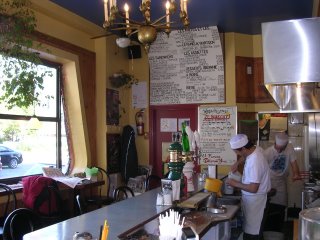
What these prices tell you is that Montreal, vibrant and desirable as it is, has not abdicated its social responsibility to entire segments of the population. Blue-collar residents live in plain neighborhoods. However stylishly unremarkable, having affordable housing close to a city center’s skyscrapers is remarkable when the tempting and usual solution is to relegate the less well off to tenements. Or to push them off to distant suburbs. It flies in the face of our conventional wisdom and I support it.
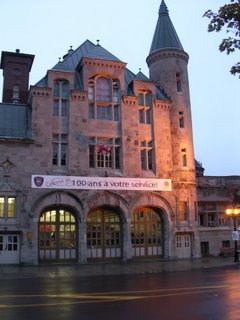
I had asked Anic to see whether she and Alain would want to catch a play. “La Visite de la Vieille Dame,” chronicles the return to an impoverished village of a wealthy and now aging native daughter. It satirizes the duplicity and hypocrisy of the denizens, without succumbing to a good-versus-bad formula. It was staged at the Rideau Vert on the Plateau, one of the city’s oldest theater.
The family met at the Musée des Beaux-Arts to catch a Provence impressionistic retrospective. Anic and I attended a press photography exhibit. I finished my artistic soakings at the suitably funky but not inescapable Musée d’Art Contemporain. I also attended a reunion and discussion on the criminal justice system at the Université de Montréal. Privately I saw several French-language films, including “C.R.A.Z.Y.,” the highest grossing, Québec produced, film in the province. It was entered as Canada’s nomination for the 2006 Academy Awards and I was hoping for a win if only to see it at a local movie theater, this time in English. I had difficulty understanding the nuances of this coming out story that plots the emotional development and sexual maturity of Zachary (the “Z” in the movie title – his siblings share the other letters), first at birth, then at age 7, 14 and 21. The film was released with subtitles in France!
I got the message, however, behind the heart-wrenching tale of “L’Audition,” and got teary eyes. The complexities of life sometimes turn even the noblest decisions into an obstacle course. Without being sentimental, this wonderful film touches on universal pains.
We picked my next-to-last night in town for a visit to the annual Lanternes Chinoises decorations at the Jardins Botaniques. I expected a few haphazardly strung together Chinese lanterns, maybe some symbolism thrown in. Alain and Anic had gone to the gardens once before and endorsed a return visit.
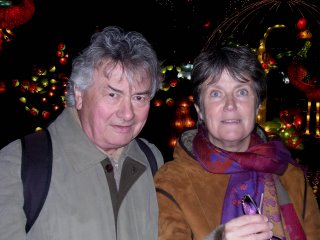

The place was jammed at 7 p.m. and I wondered what could be so significant in a few darn lanterns. The Pie IX subway stop was also packed thanks to a soccer game at the Olympic Stadium across the street (and next to the excellent Biodome).
The crowd led us to Asian pavilions festively decked in hundreds of exquisite lanterns. We circled a large pond and marveled at the light reflections in the water. Over arched bridges, past small cascades, we entered pagodas and a universe of brightly lit, yet tasteful, lanterns and animals, seemingly floating in the night sky.
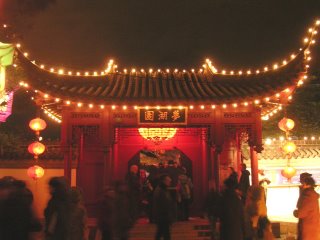

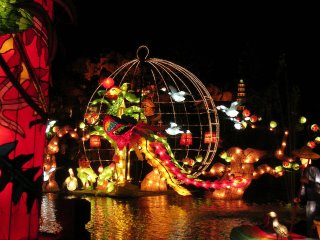
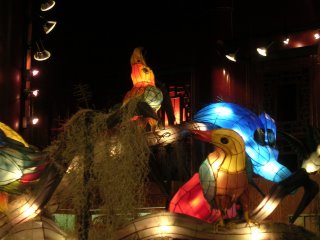
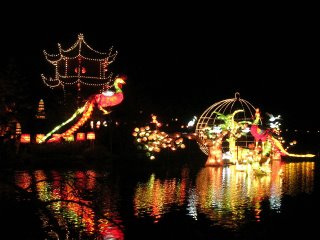
I would like to float some more myself.
J'suis pas bourru, pt'etre un peu tanné, mais surtout, j'me trouve un peu ecarté ...
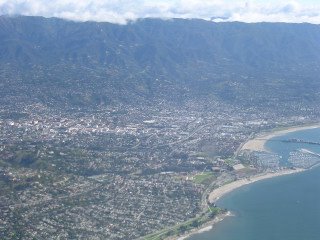
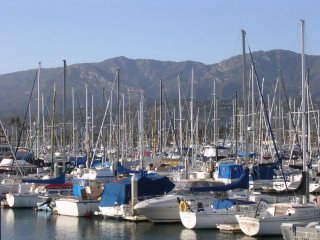 The harbor with the Santa Ynez mountains in the background.
The harbor with the Santa Ynez mountains in the background.
 Approaching the eucalyptus trees landmark on the Cold Springs trail, halfway to Camino Cielo, the mountain's ridgetop.
Approaching the eucalyptus trees landmark on the Cold Springs trail, halfway to Camino Cielo, the mountain's ridgetop.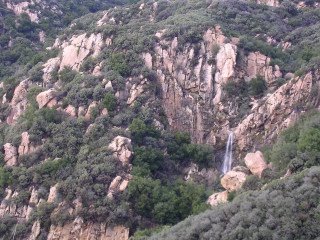 A seasonal and rare waterfall in a side canyon of the Rattlesnake drainage.
A seasonal and rare waterfall in a side canyon of the Rattlesnake drainage.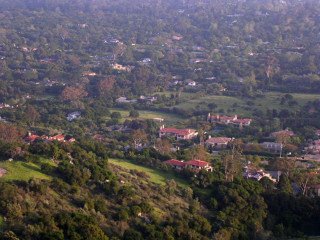 Montecito foothills.
Montecito foothills.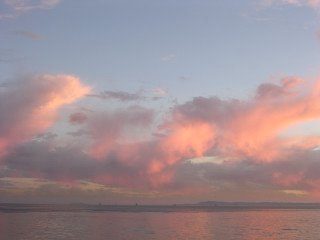
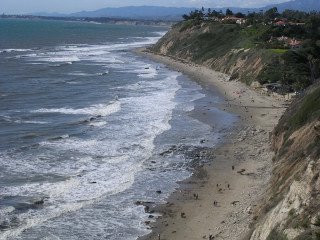 Henry's Beach, officially named Arroyo Burro, below the Wilcox Property.
Henry's Beach, officially named Arroyo Burro, below the Wilcox Property. 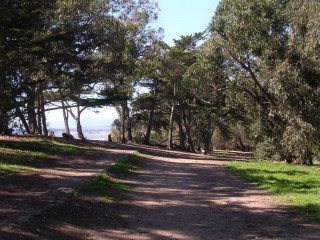 Bluff top trail on the Wilcox Property, one of four large oceanfront tract that has been saved from development. Since actors Kirk and Michael Douglas put some money toward its preservation, it now goes by the gentle name of Douglas Family Preserve.
Bluff top trail on the Wilcox Property, one of four large oceanfront tract that has been saved from development. Since actors Kirk and Michael Douglas put some money toward its preservation, it now goes by the gentle name of Douglas Family Preserve.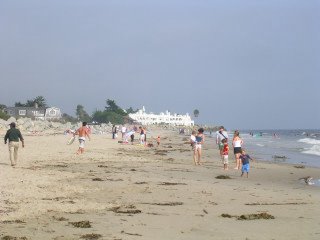 Santa Claus Beach, with Moorish-looking building in background.
Santa Claus Beach, with Moorish-looking building in background. 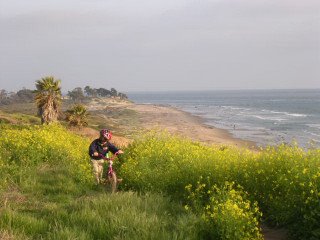 Biker amidst mustard plants at Ellwood, another of the preserved properties.
Biker amidst mustard plants at Ellwood, another of the preserved properties.